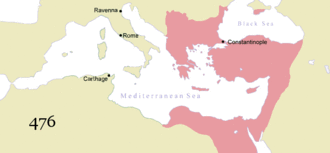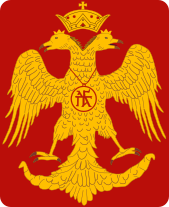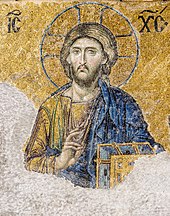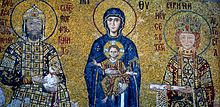Byzantine Empire
![]()
Ostrom is a redirect to this article. For other meanings, see Ostrom (disambiguation).
The Byzantine Empire, also shortened to Byzantium, or - due to its historical origin - the Eastern Roman Empire or Ostrom, was an empire in the eastern Mediterranean region. It emerged from the eastern half of the Roman Empire in the course of Late Antiquity after the so-called division of the empire in 395. Ruled from the capital at Constantinople-also called "Byzantium"-the empire extended from Italy and the Balkan Peninsula to the Arabian Peninsula and North Africa during its greatest expansion in the mid-sixth century, but was largely confined to Asia Minor and southeastern Europe from the seventh century onward. The empire ended with the conquest of Constantinople by the Ottomans in 1453.
The history of the Byzantine Empire was marked by a defensive struggle on its borders against external enemies, which placed considerable demands on the empire's forces. In the process, phases of expansion (after territorial losses in the seventh century, conquests in the tenth and eleventh centuries) alternated with phases of retreat until the late period, when the empire no longer had sufficient resources. Internally, theological disputes of varying intensity and isolated civil wars occurred repeatedly (especially until the ninth century), but the foundation of the state, oriented on Roman structures, remained largely intact until the early thirteenth century. Culturally, Byzantium bequeathed significant works of law, literature, and art to the modern era. Byzantium also played an important mediating role because of its more strongly preserved ancient heritage. In terms of the Christianization of Eastern Europe, referring to the Balkan region and Russia, Byzantine influence was also of great importance.

The territorial changes of the Byzantine Empire
Military
See also: Byzantine Army and Byzantine Navy
Byzantium had a standing army throughout its history, quite unlike the medieval empires in Europe. The Roman army system of late antiquity was completely reorganized in the Middle Byzantine period. In the second half of the seventh century, permanent military districts (themes) emerged, which for a long time were the cornerstones of Byzantine defense against external enemies. The army and fleet each broke down into a central unit in the capital and local troops stationed in the provinces, with the four major theme armies of the seventh and eighth centuries probably numbering about 10,000 men each. Overall, the Byzantine army proved to be a fairly effective force (admittedly depending on the respective commanders and logistics), but its total strength can only be roughly estimated. In the seventh century it might have been about 100,000 men, in the eighth century about 80,000 men and around 1000 about 250,000 men. However, the Byzantine army lost its clout over time, especially from the 13th century onwards, the troops proved unable to effectively withstand the external threat. Byzantium lacked sufficient financial resources at this time and also had to rely heavily on mercenaries, which further exacerbated the situation. With the loss of central territories (especially in Asia Minor to the Turks), the Byzantine army also shrank more and more and became marginal. The Byzantine navy, which had still played an important role in the Middle Byzantine period, hardly existed in the Late Byzantine period.

As the national emblem of the Byzantine Empire under the Palaiologians, the double-headed eagle symbolized the Christian Roman emperor's claim to rule over both halves of the empire.
Cultural perpetuation
See also: Conquest of Constantinople (1453)
After the fall of Constantinople in 1453, refugees from Byzantium, including numerous scholars, brought their scientific and technical knowledge and the ancient writings of the Greek thinkers to the cities of Western Europe, where they contributed significantly to the development of the Renaissance. Byzantine culture persisted longest on what was then Venetian Crete, which went down in history as the so-called "Byzantine Renaissance". These remnants of autonomous Hellenistic-Byzantine culture were ended with the conquest of the island by the Ottomans in 1669.
To this day, Byzantine culture continues to have an effect, especially in the rite of the Eastern Orthodox churches. Through Byzantine missionary work, Orthodox Christianity spread to many Slavic peoples and remains the predominant denomination in Eastern Europe and Greece, in parts of Southeastern Europe and Caucasia, and among most Arab Christians. Byzantine culture and thought has deeply influenced all Orthodox peoples.
The Slavic empires in the Balkans and on the Black Sea adopted profane Byzantine customs as well as the Orthodox Church. Russia, Serbia, Ukraine and Belarus in particular, but also to a somewhat lesser extent Bulgaria, were to continue the legacy of the Byzantine Empire.
As early as the ninth century, the Rus came into contact with Byzantium, as a result of which - despite repeated attempts on the part of the Rus to conquer Constantinople - intensive economic and diplomatic relations developed between the Byzantine Empire and the empire of Kievan Rus, which led to the conversion of the Rus to the Orthodox faith in 988. In the following centuries, numerous magnificent churches were built on the Byzantine model on East Slavic territory. Thus, Russian architecture and art has, besides (mostly later) Scandinavian and originally Slavic, mainly Byzantine roots. The same applies in full measure to the architecture and art of Ukraine and Belarus.
After the fall of the Byzantine Empire, the Russian Muscovite Empire then adopted Byzantine ceremonial in many parts. The Patriarch of Moscow soon attained a position whose importance resembled that of the Patriarch of Constantinople. As the most economically powerful Orthodox nation, Russia soon considered itself the Third Rome in succession to Constantinople. Ivan III, ruler of the Grand Duchy of Moscow, married Constantine XI's niece, Zoe, and adopted the Byzantine double-headed eagle as his heraldic animal. Ivan IV, called "the Terrible", was the first Muscovite ruler to eventually be officially crowned tsar.
But the Ottoman sultans also considered themselves the legitimate heirs of the Byzantine Empire, although the Seljuk and Ottoman Turks had been arch-enemies of the Rhomaeans for centuries and had ultimately conquered the Byzantine Empire. Even Sultan Mehmed II referred to himself as "Kayser-i Rum" (Emperor of Rome) - the sultans thus quite deliberately placed themselves in the continuity of the (Eastern) Roman Empire in order to legitimize themselves. The Ottoman Empire, which developed in conflict with Byzantium, had more in common with the latter than just geographical space. The historian Arnold J. Toynbee described the Ottoman Empire - albeit very controversially - as a universal state of the "Christian Orthodox social body". In any case, the Byzantine Empire did not find a constitutional continuation in it.
Last but not least, the cultural and linguistic heritage of Byzantium lives on in today's Greeks, especially in modern Greece and Cyprus, as well as in the Greek Orthodox Church (especially also in the Patriarchate of Constantinople in Istanbul). Until the beginning of the 20th century, moreover, the Greek settlement area still coincided in large parts with the Byzantine heartlands.

Christ Pantocrator in the Deësis Mosaic of Hagia Sophia (13th century)

Mosaic from the Hagia Sophia: Our Lady with John II Komnenos and Empress Irene (c. 1118)
Questions and Answers
Q: What was the Byzantine Empire?
A: The Byzantine Empire was the eastern part of the Roman Empire that survived into the Middle Ages.
Q: What was the capital of the Byzantine Empire?
A: The capital of the Byzantine Empire was Constantinople, which is now called Istanbul.
Q: What was the most important language in the Byzantine Empire?
A: Unlike the Western Roman Empire, the most important language in the Byzantine Empire was Greek, not Latin.
Q: What dominated the culture and identity of the Byzantine Empire?
A: Greek culture and identity dominated the Byzantine Empire.
Q: When did the Byzantine Empire exist?
A: The Byzantine Empire existed during the Middle Ages.
Q: What was the other name for the Byzantine Empire?
A: The other name for the Byzantine Empire was Eastern Roman Empire.
Q: Did the Byzantine Empire speak Latin or Greek?
A: The Byzantine Empire spoke Greek, not Latin.
Search within the encyclopedia